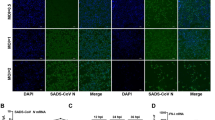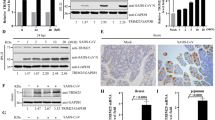Abstract
Porcine epidemic diarrhea virus (PEDV) causes severe economic loss in the pig industry each year. To better understand the relationship between cytokines and PEDV replication, in this study, pro-inflammatory cytokine and chemokine expression profiles in Vero cells infected with PEDV were analyzed. Real-time quantitative PCR assay indicated that IL-1α, IL-1β, TNF-α, CCL2, CCL5 and CXCL8 expression levels were significantly upregulated. Moreover, overexpression and siRNA silencing assays showed that overexpression of IL-1α, IL-1β, TNF-α, CCL2, CCL5 and CXCL8 could significantly inhibit PEDV replication, while silencing of IL-1α, IL-1β, TNF-α, CCL2, CCL5 and CXCL8 could significantly promote PEDV replication. Finally, a dual-luciferase reporter assay showed that nsp4 contributed to the expression of IL-1α, IL-1β, TNF-α, CCL2, CCL5 and CXCL8 via the NF-κB pathway. Together, these data determined that PEDV nsp4 could upregulate pro-inflammatory cytokine and chemokine expression, inhibiting viral replication in vitro. These results provided novel insights for understanding the roles of cytokines in PEDV replication.



Similar content being viewed by others
Abbreviations
- PEDV:
-
Porcine epidemic diarrhea virus
- ORFs:
-
Open reading frames
- nsps:
-
Nonstructural proteins
- S:
-
Spike protein
- M:
-
Membrane protein
- E:
-
Envelope protein
- N:
-
Nucleocapsid protein
- IFN:
-
Interferon
- FBS:
-
Fetal bovine serum (Thermo)
- PAMs:
-
Porcine alveolar macrophages
- RT-PCR:
-
Reverse transcription polymerase chain reaction
- RT-qPCR:
-
Real-time quantitative polymerase chain reaction
- CT:
-
Threshold cycle
- OD:
-
Optical density
- SD:
-
Standard deviations
- PBL:
-
Peripheral blood leucocytes
- PCV2:
-
Porcine circovirus type 2
- PBMCs:
-
Peripheral blood mononuclear cells
References
Ducatelle R, Coussement W, Pensaert MB, Debouck P, Hoorens J (1981) In vivo morphogenesis of a new porcine enteric coronavirus, CV 777. Arch Virol 68:35–44
Pensaert MB, de Bouck P (1978) A new coronavirus-like particle associated with diarrhea in swine. Arch Virol 58:243–247
Hao J, Xue C, He L, Wang Y, Cao Y (2014) Bioinformatics insight into the spike glycoprotein gene of field porcine epidemic diarrhea strains during 2011–2013 in Guangdong, China. Virus Genes 49:58–67
Zhao X, Li Z, Zeng X, Zhang G, Niu J, Sun B, Ma J (2017) Sequence analysis of the spike gene of Porcine epidemic diarrhea virus isolated from South China during 2011–2015. J Vet Sci 18:237–243
Fan B, Yu Z, Pang F, Xu X, Zhang B, Guo R, He K, Li B (2017) Characterization of a pathogenic full-length cDNA clone of a virulent porcine epidemic diarrhea virus strain AH2012/12 in China. Virology 500:50–61
Song D, Park B (2012) Porcine epidemic diarrhoea virus: a comprehensive review of molecular epidemiology, diagnosis, and vaccines. Virus Genes 44:167–175
Duarte M, Gelfi J, Lambert P, Rasschaert D, Laude H (1993) Genome organization of porcine epidemic diarrhoea virus. Adv Exp Med Biol 342:55–60
Julkunen I, Sareneva T, Pirhonen J, Ronni T, Melen K, Matikainen S (2001) Molecular pathogenesis of influenza A virus infection and virus-induced regulation of cytokine gene expression. Cytokine Growth Factor Rev 12:171–180
Mackay CR (2001) Chemokines: immunology’s high impact factors. Nat Immunol 2:95–101
Quinlivan M, Nelly M, Prendergast M, Breathnach C, Horohov D, Arkins S, Chiang YW, Chu HJ, Ng T, Cullinane A (2007) Pro-inflammatory and antiviral cytokine expression in vaccinated and unvaccinated horses exposed to equine influenza virus. Vaccine 25:7056–7064
Lusso P (2015) Chemokines and HIV: the first close encounter. Front Immunol 6:294
Senthilkumar D, Rajukumar K, Kumar M, Kalaiyarasu S, Shrivastava D, Katare M, Kulkarni DD, Singh VP (2019) Porcine reproductive and respiratory syndrome virus induces concurrent elevation of High Mobility Group Box-1 protein and pro-inflammatory cytokines in experimentally infected piglets. Cytokine 113:21–30
Li L, Fu F, Xue M, Chen W, Liu J, Shi H, Chen J, Bu Z, Feng L, Liu P (2017) IFN-lambda preferably inhibits PEDV infection of porcine intestinal epithelial cells compared with IFN-alpha. Antiviral Res 140:76–82
Shen H, Zhang C, Guo P, Liu Z, Sun M, Sun J, Li L, Dong J, Zhang J (2016) Short communication: antiviral activity of porcine IFN-lambda3 against porcine epidemic diarrhea virus in vitro. Virus Genes 52:877–882
Guo X, Hu H, Chen F, Li Z, Ye S, Cheng S, Zhang M, He Q (2016) iTRAQ-based comparative proteomic analysis of Vero cells infected with virulent and CV777 vaccine strain-like strains of porcine epidemic diarrhea virus. J Proteomics 130:65–75
Lin H, Li B, Chen L, Ma Z, He K, Fan H (2017) Differential protein analysis of IPEC-J2 cells infected with porcine epidemic diarrhea virus pandemic and classical strains elucidates the pathogenesis of infection. J Proteome Res 16:2113–2120
Jung K, Miyazaki A, Saif LJ (2018) Immunohistochemical detection of the vomiting-inducing monoamine neurotransmitter serotonin and enterochromaffin cells in the intestines of conventional or gnotobiotic (Gn) pigs infected with porcine epidemic diarrhea virus (PEDV) and serum cytokine responses of Gn pigs to acute PEDV infection. Res Vet Sci 119:99–108
Palomo J, Dietrich D, Martin P, Palmer G, Gabay C (2015) The interleukin (IL)-1 cytokine family—balance between agonists and antagonists in inflammatory diseases. Cytokine 76:25–37
Dinarello CA (2000) Proinflammatory cytokines. Chest 118:503–508
Krajcsi P, Wold WS (1998) Inhibition of tumor necrosis factor and interferon triggered responses by DNA viruses. Semin Cell Dev Biol 9:351–358
Wong GH, Goeddel DV (1986) Tumour necrosis factors alpha and beta inhibit virus replication and synergize with interferons. Nature 323:819–822
Wang C, Shi X, Zhang X, Wang A, Wang L, Chen J, Deng R, Zhang G (2015) The endoribonuclease activity essential for the nonstructural protein 11 of porcine reproductive and respiratory syndrome virus to inhibit NLRP3 inflammasome-mediated IL-1beta induction. DNA Cell Biol 34:728–735
Han J, Zhang S, Zhang Y, Chen M, Lv Y (2017) Porcine circovirus type 2 increases interleukin-1beta and interleukin-10 production via the MyD88-NF-kappa B signaling pathway in porcine alveolar macrophages in vitro. J Vet Sci 18:183–191
Sipos W, Duvigneau JC, Willheim M, Schilcher F, Hartl RT, Hofbauer G, Exel B, Pietschmann P, Schmoll F (2004) Systemic cytokine profile in feeder pigs suffering from natural postweaning multisystemic wasting syndrome (PMWS) as determined by semiquantitative RT-PCR and flow cytometric intracellular cytokine detection. Vet Immunol Immunopathol 99:63–71
Sallusto F, Mackay CR, Lanzavecchia A (2000) The role of chemokine receptors in primary, effector, and memory immune responses. Annu Rev Immunol 18:593–620
Wack A, Openshaw P, O’Garra A (2011) Contribution of cytokines to pathology and protection in virus infection. Curr Opin Virol 1:184–195
Appay V, Rowland-Jones SL (2001) RANTES: a versatile and controversial chemokine. Trends Immunol 22:83–87
Gerszten RE, Garcia-Zepeda EA, Lim YC, Yoshida M, Ding HA, Gimbrone MJ, Luster AD, Luscinskas FW, Rosenzweig A (1999) MCP-1 and IL-8 trigger firm adhesion of monocytes to vascular endothelium under flow conditions. Nature 398:718–723
Gesser B, Lund M, Lohse N, Vestergaad C, Matsushima K, Sindet-Pedersen S, Jensen SL, Thestrup-Pedersen K, Larsen CG (1996) IL-8 induces T cell chemotaxis, suppresses IL-4, and up-regulates IL-8 production by CD4+ T cells. J Leukoc Biol 59:407–411
Gouwy M, Struyf S, Noppen S, Schutyser E, Springael JY, Parmentier M, Proost P, Van Damme J (2008) Synergy between coproduced CC and CXC chemokines in monocyte chemotaxis through receptor-mediated events. Mol Pharmacol 74:485–495
Alcami A, Lira SA (2010) Modulation of chemokine activity by viruses. Curr Opin Immunol 22:482–487
Heidarieh H, Hernaez B, Alcami A (2015) Immune modulation by virus-encoded secreted chemokine binding proteins. Virus Res 209:67–75
Stern JL, Slobedman B (2008) Human cytomegalovirus latent infection of myeloid cells directs monocyte migration by up-regulating monocyte chemotactic protein-1. J Immunol 180:6577–6585
Hamilton ST, Scott GM, Naing Z, Rawlinson WD (2013) Human cytomegalovirus directly modulates expression of chemokine CCL2 (MCP-1) during viral replication. J Gen Virol 94:2495–2503
Wang Y, Luo R, Fang L, Wang D, Bi J, Chen H, Xiao S (2011) Porcine reproductive and respiratory syndrome virus (PRRSV) infection activates chemokine RANTES in MARC-145 cells. Mol Immunol 48:586–591
Chen CJ, Chen JH, Chen SY, Liao SL, Raung SL (2004) Upregulation of RANTES gene expression in neuroglia by Japanese encephalitis virus infection. J Virol 78:12107–12119
Kujime K, Hashimoto S, Gon Y, Shimizu K, Horie T (2000) p38 mitogen-activated protein kinase and c-jun-NH2-terminal kinase regulate RANTES production by influenza virus-infected human bronchial epithelial cells. J Immunol 164:3222–3228
Fishbourne E, Hutet E, Abrams C, Cariolet R, Le Potier MF, Takamatsu HH, Dixon LK (2013) Increase in chemokines CXCL10 and CCL2 in blood from pigs infected with high compared to low virulence African swine fever virus isolates. Vet Res 44:87
Fishbourne E, Abrams CC, Takamatsu HH, Dixon LK (2013) Modulation of chemokine and chemokine receptor expression following infection of porcine macrophages with African swine fever virus. Vet Microbiol 162:937–943
Chen XX, Quan R, Guo XK, Gao L, Shi J, Feng WH (2014) Up-regulation of pro-inflammatory factors by HP-PRRSV infection in microglia: implications for HP-PRRSV neuropathogenesis. Vet Microbiol 170:48–57
Mamik MK, Ghorpade A (2014) Chemokine CXCL8 promotes HIV-1 replication in human monocyte-derived macrophages and primary microglia via nuclear factor-kappaB pathway. PLoS One 9:e92145
Bi J, Song S, Fang L, Wang D, Jing H, Gao L, Cai Y, Luo R, Chen H, Xiao S (2014) Porcine reproductive and respiratory syndrome virus induces IL-1beta production depending on TLR4/MyD88 pathway and NLRP3 inflammasome in primary porcine alveolar macrophages. Mediat Inflamm 2014:403515
Subramaniam S, Kwon B, Beura LK, Kuszynski CA, Pattnaik AK, Osorio FA (2010) Porcine reproductive and respiratory syndrome virus non-structural protein 1 suppresses tumor necrosis factor-alpha promoter activation by inhibiting NF-kappaB and Sp1. Virology 406:270–279
He Q, Li Y, Zhou L, Ge X, Guo X, Yang H (2015) Both Nsp1beta and Nsp11 are responsible for differential TNF-alpha production induced by porcine reproductive and respiratory syndrome virus strains with different pathogenicity in vitro. Virus Res 201:32–40
Zhang H, Lunney JK, Baker RB, Opriessnig T (2011) Cytokine and chemokine mRNA expression profiles in tracheobronchial lymph nodes from pigs singularly infected or coinfected with porcine circovirus type 2 (PCV2) and Mycoplasma hyopneumoniae (MHYO). Vet Immunol Immunopathol 140:152–158
Xu X, Zhang H, Zhang Q, Dong J, Liang Y, Huang Y, Liu HJ, Tong D (2013) Porcine epidemic diarrhea virus E protein causes endoplasmic reticulum stress and up-regulates interleukin-8 expression. Virol J 10:26
Xu X, Zhang H, Zhang Q, Huang Y, Dong J, Liang Y, Liu HJ, Tong D (2013) Porcine epidemic diarrhea virus N protein prolongs S-phase cell cycle, induces endoplasmic reticulum stress, and up-regulates interleukin-8 expression. Vet Microbiol 164:212–221
Acknowledgements
This work was supported by the National Key Research and Development Program of China (2018YFD0501102), the National Key Technologies R&D Program (2015BAD12B02-5), the Guangzhou City Project (201508020062), and the Henan Science and Technology Project (182102110037).
Funding
This work was supported by the National Key Research and Development Program of China (2018YFD0501102), the National Key Technologies R&D Program (2015BAD12B02-5), the Guangzhou City Project (201508020062), and the Henan Science and Technology Project (182102110037).
Author information
Authors and Affiliations
Contributions
Conceived and designed the experiments: Linyang Yu, Jianguo Dong, Changxu Song. Performed the experiments: Linyang Yu, Jianguo Dong, Yanwu Wang, Pengfei Zhang, Yanling Liu, Leyi Zhang, Pengshuai Liang, Lei Wang, Changxu Song. Analyzed the data and wrote the paper: Linyang Yu, Jianguo Dong, Changxu Song.
Corresponding author
Ethics declarations
Conflict of interest
The authors declare no conflicts of interest.
Ethics approval and consent to participate
All of the samples were collected according to the animal ethics regulations of the National Engineering Center for Swine Breeding Industry (NECSBI 2015-16).
Consent for publication
Not applicable.
Availability of data and materials
Genetic data presented in this paper are publicly available via GenBank.
Additional information
Handling Editor: Zhenhai Chen.
Publisher's Note
Springer Nature remains neutral with regard to jurisdictional claims in published maps and institutional affiliations.
Electronic supplementary material
Below is the link to the electronic supplementary material.
Rights and permissions
About this article
Cite this article
Yu, L., Dong, J., Wang, Y. et al. Porcine epidemic diarrhea virus nsp4 induces pro-inflammatory cytokine and chemokine expression inhibiting viral replication in vitro. Arch Virol 164, 1147–1157 (2019). https://doi.org/10.1007/s00705-019-04176-2
Received:
Accepted:
Published:
Issue Date:
DOI: https://doi.org/10.1007/s00705-019-04176-2




